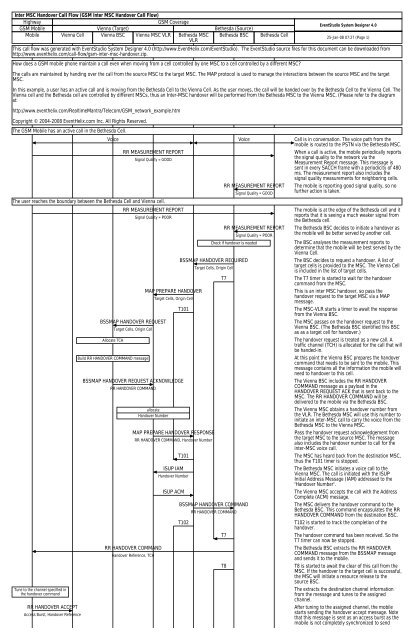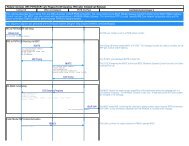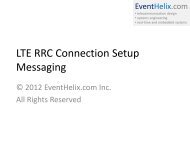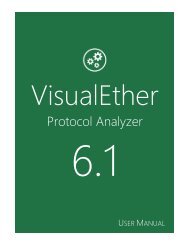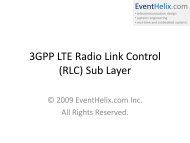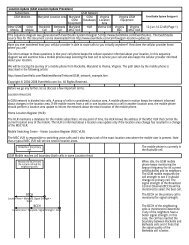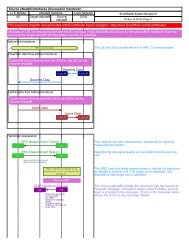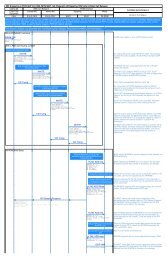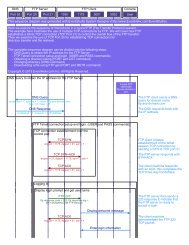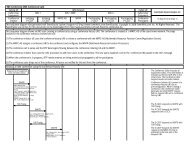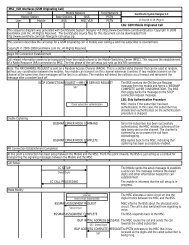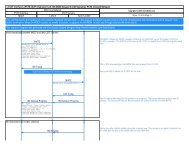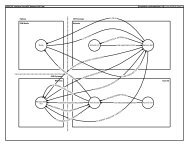Inter MSC Handover Poster - EventHelix.com
Inter MSC Handover Poster - EventHelix.com
Inter MSC Handover Poster - EventHelix.com
Create successful ePaper yourself
Turn your PDF publications into a flip-book with our unique Google optimized e-Paper software.
<strong>Inter</strong> <strong>MSC</strong> <strong>Handover</strong> Call Flow (GSM <strong>Inter</strong> <strong>MSC</strong> <strong>Handover</strong> Call Flow)<br />
Highway<br />
GSM Coverage<br />
GSM Mobile Vienna (Target) Bethesda (Source)<br />
Mobile Vienna Cell Vienna BSC Vienna <strong>MSC</strong> VLR Bethesda <strong>MSC</strong><br />
VLR<br />
Bethesda BSC<br />
Bethesda Cell<br />
EventStudio System Designer 4.0<br />
25-Jan-08 07:27 (Page 1)<br />
This call flow was generated with EventStudio System Designer 4.0 (http://www.<strong>EventHelix</strong>.<strong>com</strong>/EventStudio). The EventStudio source files for this document can be downloaded from<br />
http://www.eventhelix.<strong>com</strong>/call-flow/gsm-inter-msc-handover.zip.<br />
How does a GSM mobile phone maintain a call even when moving from a cell controlled by one <strong>MSC</strong> to a cell controlled by a different <strong>MSC</strong>?<br />
The calls are maintained by handing over the call from the source <strong>MSC</strong> to the target <strong>MSC</strong>. The MAP protocol is used to manage the interactions between the source <strong>MSC</strong> and the target<br />
<strong>MSC</strong>.<br />
In this example, a user has an active call and is moving from the Bethesda Cell to the Vienna Cell. As the user moves, the call will be handed over by the Bethesda Cell to the Vienna Cell. The<br />
Vienna cell and the Bethesda cell are controlled by different <strong>MSC</strong>s, thus an <strong>Inter</strong>-<strong>MSC</strong> handover will be performed from the Bethesda <strong>MSC</strong> to the Vienna <strong>MSC</strong>. (Please refer to the diagram<br />
at:<br />
http://www.eventhelix.<strong>com</strong>/RealtimeMantra/Tele<strong>com</strong>/GSM_network_example.htm<br />
Copyright © 2004-2008 <strong>EventHelix</strong>.<strong>com</strong> Inc. All Rights Reserved.<br />
The GSM Mobile has an active call in the Bethesda Cell.<br />
The user reaches the boundary between the Bethesda Cell and Vienna cell.<br />
Tune to the channel specified in<br />
the handover <strong>com</strong>mand<br />
RR HANDOVER ACCEPT<br />
Access Burst, <strong>Handover</strong> Reference<br />
Voice Voice Call is in conversation. The voice path from the<br />
mobile is routed to the PSTN via the Bethesda <strong>MSC</strong>.<br />
RR MEASUREMENT REPORT<br />
Signal Quality = GOOD<br />
When a call is active, the mobile periodically reports<br />
the signal quality to the network via the<br />
Measurement Report message. This message is<br />
sent in every SACCH frame with a periodicity of 480<br />
ms. The measurement report also includes the<br />
signal quality measurements for neighboring cells.<br />
RR MEASUREMENT REPORT<br />
Signal Quality = GOOD<br />
The mobile is reporting good signal quality, so no<br />
further action is taken.<br />
RR MEASUREMENT REPORT<br />
Signal Quality = POOR<br />
BSSMAP HANDOVER REQUEST<br />
Allocate TCH<br />
Target Cells, Origin Cell<br />
Build RR HANDOVER COMMAND message<br />
MAP PREPARE HANDOVER<br />
Target Cells, Origin Cell<br />
RR MEASUREMENT REPORT<br />
Signal Quality = POOR<br />
Check if handover is needed<br />
BSSMAP HANDOVER REQUIRED<br />
T101<br />
BSSMAP HANDOVER REQUEST ACKNOWLEDGE<br />
RR HANDOVER COMMAND<br />
allocate<br />
<strong>Handover</strong> Number<br />
Target Cells, Origin Cell<br />
MAP PREPARE HANDOVER RESPONSE<br />
RR HANDOVER COMMAND<br />
<strong>Handover</strong> Reference, TCH<br />
RR HANDOVER COMMAND, <strong>Handover</strong> Number<br />
T101<br />
ISUP IAM<br />
<strong>Handover</strong> Number<br />
ISUP ACM<br />
T7<br />
BSSMAP HANDOVER COMMAND<br />
T102<br />
RR HANDOVER COMMAND<br />
T7<br />
T8<br />
The mobile is at the edge of the Bethesda cell and it<br />
reports that it is seeing a much weaker signal from<br />
the Bethesda cell.<br />
The Bethesda BSC decides to initiate a handover as<br />
the mobile will be better served by another cell.<br />
The BSC analyses the measurement reports to<br />
determine that the mobile will be best served by the<br />
Vienna Cell.<br />
The BSC decides to request a handover. A list of<br />
target cells is provided to the <strong>MSC</strong>. The Vienna Cell<br />
is included in the list of target cells.<br />
The T7 timer is started to wait for the handover<br />
<strong>com</strong>mand from the <strong>MSC</strong>.<br />
This is an inter <strong>MSC</strong> handover, so pass the<br />
handover request to the target <strong>MSC</strong> via a MAP<br />
message.<br />
The <strong>MSC</strong>-VLR starts a timer to await the response<br />
from the Vienna BSC.<br />
The <strong>MSC</strong> passes on the handover request to the<br />
Vienna BSC. (The Bethesda BSC identified this BSC<br />
as as a target cell for handover.)<br />
The handover request is treated as a new call. A<br />
traffic channel (TCH) is allocated for the call that will<br />
be handed-in.<br />
At this point the Vienna BSC prepares the handover<br />
<strong>com</strong>mand that needs to be sent to the mobile. This<br />
message contains all the information the mobile will<br />
need to handover to this cell.<br />
The Vienna BSC includes the RR HANDOVER<br />
COMMAND message as a payload in the<br />
HANDOVER REQUEST ACK that is sent back to the<br />
<strong>MSC</strong>. The RR HANDOVER COMMAND will be<br />
delivered to the mobile via the Bethesda BSC.<br />
The Vienna <strong>MSC</strong> obtains a handover number from<br />
the VLR. The Bethesda <strong>MSC</strong> will use this number to<br />
initiate an inter-<strong>MSC</strong> call to carry the voice from the<br />
Bethesda <strong>MSC</strong> to the Vienna <strong>MSC</strong>.<br />
Pass the handover request acknowledgement from<br />
the target <strong>MSC</strong> to the source <strong>MSC</strong>. The message<br />
also includes the handover number to call for the<br />
inter-<strong>MSC</strong> voice call.<br />
The <strong>MSC</strong> has heard back from the destination <strong>MSC</strong>,<br />
thus the T101 timer is stopped.<br />
The Bethesda <strong>MSC</strong> initiates a voice call to the<br />
Vienna <strong>MSC</strong>. The call is initiated with the ISUP<br />
Initial Address Message (IAM) addressed to the<br />
"<strong>Handover</strong> Number".<br />
The Vienna <strong>MSC</strong> accepts the call with the Address<br />
Complete (ACM) message.<br />
The <strong>MSC</strong> delivers the handover <strong>com</strong>mand to the<br />
Bethesda BSC. This <strong>com</strong>mand encapsulates the RR<br />
HANDOVER COMMAND from the destination BSC.<br />
T102 is started to track the <strong>com</strong>pletion of the<br />
handover.<br />
The handover <strong>com</strong>mand has been received. So the<br />
T7 timer can now be stopped.<br />
The Bethesda BSC extracts the RR HANDOVER<br />
COMMAND message from the BSSMAP message<br />
and sends it to the mobile.<br />
T8 is started to await the clear of this call from the<br />
<strong>MSC</strong>. If the handover to the target cell is successful,<br />
the <strong>MSC</strong> will initiate a resource release to the<br />
source BSC.<br />
The extracts the destination channel information<br />
from the message and tunes to the assigned<br />
channel.<br />
After tuning to the assigned channel, the mobile<br />
starts sending the handover accept message. Note<br />
that this message is sent as an access burst as the<br />
mobile is not <strong>com</strong>pletely synchronized to send
<strong>Inter</strong> <strong>MSC</strong> <strong>Handover</strong> Call Flow (GSM <strong>Inter</strong> <strong>MSC</strong> <strong>Handover</strong> Call Flow)<br />
Highway<br />
GSM Coverage<br />
GSM Mobile Vienna (Target) Bethesda (Source)<br />
Mobile Vienna Cell Vienna BSC Vienna <strong>MSC</strong> VLR Bethesda <strong>MSC</strong><br />
VLR<br />
Bethesda BSC<br />
T3124<br />
RR PHYSICAL INFORMATION<br />
T3124<br />
<strong>Handover</strong> Reference<br />
RR HANDOVER ACCEPT<br />
Access Burst, <strong>Handover</strong> Reference<br />
RR PHYSICAL INFORMATION<br />
RR SABM<br />
RR UA<br />
<strong>Handover</strong> Reference<br />
RR HANDOVER COMPLETE<br />
BSSMAP HANDOVER DETECTED<br />
T3105<br />
T3105<br />
BSSMAP HANDOVER COMPLETE<br />
MAP ACCESS SIGNALING REQUEST<br />
HANDOVER DETECTED<br />
MAP SEND END SIGNAL<br />
Switch Call to new Path<br />
HANDOVER COMPLETE<br />
ISUP ANS<br />
Bethesda Cell<br />
EventStudio System Designer 4.0<br />
25-Jan-08 07:27 (Page 2)<br />
normal bursts.<br />
The T3124 timer is started to await the PHYSICAL<br />
INFORMATION message from the network.<br />
The BSC receives the HANDOVER ACCEPT from the<br />
terminal. The actual call is identified using the<br />
handover reference. (The handover reference was<br />
send in the encapsulated HANDOVER COMMAND<br />
message. )<br />
The BSC informs the <strong>MSC</strong> that the handover has<br />
been detected. At this point the <strong>MSC</strong> can switch the<br />
voice path.<br />
The <strong>Handover</strong> detect is signalled to the Bethesda<br />
<strong>MSC</strong> via the Access Signaling Request message.<br />
The BSC sends the PHYSICAL INFORMATION<br />
message to the mobile. This message contains a<br />
time and frequency correction.<br />
T3105 is started to await the receipt of the SABM<br />
for the signaling connection.<br />
The mobile applies the received corrections and can<br />
now send TCH bursts on the channel. TCH bursts<br />
contain the speech from the user.<br />
T3124 is stopped as PHYSICAL INFORMATION<br />
message has been received.<br />
Mobile sends a SABM to establish the signaling<br />
connection.<br />
Receipt of SABM stops the T3105 timer.<br />
The BSC replies with a UA message.<br />
The mobile uses the signaling connection to<br />
indicate that the handover has been <strong>com</strong>pleted.<br />
The BSC forwards the handover <strong>com</strong>pletion event to<br />
the <strong>MSC</strong>.<br />
Transport the <strong>Handover</strong> Complete message to the<br />
source <strong>MSC</strong>.<br />
The <strong>MSC</strong> switches the voice path.<br />
The Vienna <strong>MSC</strong> answers the inter-<strong>MSC</strong> voice call.<br />
Release call resources in Bethesda BSC.<br />
T102<br />
BSSMAP CLEAR COMMAND<br />
T8<br />
Release TCH<br />
<strong>Handover</strong> has been <strong>com</strong>pleted, so T102 is stopped.<br />
Call release has been <strong>com</strong>pleted, now the RR<br />
connection is released by the <strong>MSC</strong>.<br />
The T8 timer is stopped as the handed over call's<br />
resources in the source BSC are released.<br />
BSSMAP CLEAR COMPLETE<br />
The BSS informs the the <strong>MSC</strong> that the RR<br />
connection has been released.<br />
Voice Voice Voice Call is in conversation after the handover. Note that<br />
the voice path to the PSTN is via the source <strong>MSC</strong>.<br />
The destination <strong>MSC</strong> routes the voice on the ISUP<br />
call between the two <strong>MSC</strong>s.<br />
ISUP REL<br />
Subscribers have hung up. The source <strong>MSC</strong><br />
releases the voice circuit between the two <strong>MSC</strong>s.<br />
ISUP RLC<br />
ISUP release <strong>com</strong>plete.<br />
MAP SEND END SIGNAL RESPONSE<br />
The handed over call has ended.


